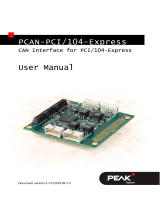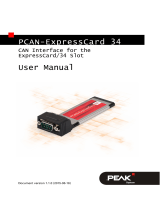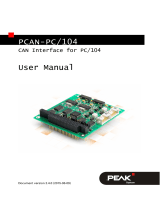Page is loading ...

CAN Repeater for the Decoupling of
Bus Segments
User Manual
PCAN-Repeater DR
Document version 2.1.0 (2019-03-13)

PCAN-Repeater DR – User Manual
2
Relevant products
Product Name Model Part number
PCAN-Repeater DR Industry IPEH-004038
PCAN® is a registered trademark of PEAK-System Technik GmbH.
Other product names in this document may be the trademarks or registered
trademarks of their respective companies. They are not explicitly marked by ™ or ®.
© 2019 PEAK-System Technik GmbH
Duplication (copying, printing, or other forms) and the electronic distribution of this
document is only allowed with explicit permission of PEAK-System Technik GmbH.
PEAK-System Technik GmbH reserves the right to change technical data without
prior announcement. The general business conditions and the regulations of the
license agreement apply. All rights are reserved.
PEAK-System Technik GmbH
Otto-Roehm-Strasse 69
64293 Darmstadt
Germany
Phone: +49 (0)6151 8173-20
Fax: +49 (0)6151 8173-29
www.peak-system.com
info@peak-system.com
Doc
ument version 2.1.0 (2019-03-13)

PCAN-Repeater DR – User Manual
3
Contents
1 Introduction 4
1.1 Properties at a Glance 4
1.2 Operation Requirements 5
1.3 Scope of Supply 5
2 Installation 6
2.1 CAN Connectors 6
2.2 Power supply connection 6
2.3 Influence on Maximum Node Distance 7
2.4 CAN Termination 8
2.5 Listen-only Mode 9
3 Operation 11
3.1 Initial Steps 11
3.2 Status LEDs 12
3.3 Bus Load and Error Indication 12
4 Application Examples 14
4.1 Decoupling of Two Bus Segments 14
4.2 Implementation of a Long Stub Line 15
5 Technical Specifications 17
Appendix A CE Certificate 19
Appendix B Dimension Drawing 20
Appendix C Operation in a CAN FD Network 21

PCAN-Repeater DR – User Manual
4
1 Introduction
The PCAN-Repeater DR establishes a connection between two High-
speed CAN buses with galvanic isolation of up to 5 kV. Both CAN
channels are decoupled from each other and from the power
supply. All message traffic including error frames is forwarded 1:1
between both channels, if necessary, in one direction only. The
PCAN-Repeater DR behaves passively and is transparent from the
perspective of the CAN bus. LEDs display the current bus status.
With its DIN rail casing and extended temperature range support,
this module is suitable for use in an industrial environment.
Due to the properties of the CAN protocol, the maximum distance of
two nodes on a CAN bus depends on the bit rate. Therefore, a CAN
bus cannot be extended with the PCAN-Repeater DR. The maximum
distance of tow nodes is decreased with each interposed PCAN-
Repeater DR according to its transit delay.
For operating the PCAN-Repeater DR in a CAN FD network, there
are notes in Appendix C on page 21.
1.1 Properties at a Glance
Two High-speed CAN channels (ISO 11898-2)
Bit rates from 5 kbit/s up to 1 Mbit/s
Compliant with CAN specifications 2.0A (11-bit ID)
and 2.0B (29-bit ID)
NXP CAN transceiver PCA82C251
Connections for CAN and power supply via 4-pin screw terminal
block (Phoenix)
LEDs display CAN bus load and CAN errors

PCAN-Repeater DR – User Manual
5
Switchable termination for each CAN channel
Galvanic isolation rated up to 5 kV according to IEC60601-1,
between both CAN channels and between CAN and power
supply
Listen-only mode for CAN channel 1 or CAN channel 2 can be
switched selectively
Plastic casing (width: 22.5 mm) for mounting on a DIN rail (IEC
60715 TH35)
Supply voltage from 8 to 30 V
Extended operating temperature range from -40 to +85 °C
(-40 to +185 °F)
1.2 Operation Requirements
Power supply in the range of 8 to 30 V DC
1.3 Scope of Supply
PCAN-Repeater DR in DIN rail plastic casing
3 mating connectors (Phoenix, type: MSTB 2,5/4-ST BK) for
power supply and CAN connectors
Manual in PDF format

PCAN-Repeater DR – User Manual
6
2 Installation
2.1 CAN Connectors
Both CAN connectors CAN 1 and CAN 2 are located on the upper
side of the casing.
Pin Assignment
1 CAN-High
2 CAN-Low
3 CAN-GND
4 CAN-Shield
1
2.2 Power supply connection
The connection for the power supply is located on the lower side of
the casing.
Pin Assignment
1 GND
2 not connected
3 Vbat (8 - 30 V DC)
4 Shield (DIN rail potential)
1
Capacitive connection (5 kV) to supply shield (DIN rail potential)

PCAN-Repeater DR – User Manual
7
2.3 Influence on Maximum Node Distance
The PCAN-Repeater DR has a transit delay of 115 ns. This
corresponds to a cable length of 23 m which reduces the maximum
distance between two nodes on both sides of the PCAN-Repeater
DR.
Due to the properties of the CAN protocol, the maximum distance of
two nodes on a CAN bus depends on the bit rate. The following
table shows the maximum distance of two nodes on the CAN bus at
different bit rates.
Bit rate Maximum distance Maxim. dist. with repeater
1 Mbit/s 40 m 17 m
500 kbit/s 110 m 87 m
250 kbit/s 240 m 217 m
125 kbit/s 500 m
50 kbit/s 1.3 km
20 kbit/s 3.3 km
10 kbit/s 6.6 km
5 kbit/s 13.0 km
Using these bit rates, the
transit delay of a repeater
can be disregarded.
The listed values have been calculated on the basis of an idealized
system and can differ from reality.
Note: The PCAN-Repeater DR cannot be used to extend the
length of a CAN bus beyond the maximum distance of two
nodes.

PCAN-Repeater DR – User Manual
8
2.4 CAN Termination
The termination for each CAN channel can be separately activated
with switches on the board. At delivery, the termination is switched
on.
A High-speed CAN bus (ISO 11898-2) must be terminated on both
cable ends with 120 Ohms. Otherwise, malfunctions may arise.
Proceed as follows to change the termination setting:
Important note: Before opening the PCAN-Repeater DR,
disconnect it from the power supply.
1. Open the plastic casing by slightly pushing the latches on
the front above the CAN connectors and at the bottom
behind the power connector, e.g. with a flat tip screwdriver.
2. Pull out the circuit board including the front part of the
casing.
Positions S1 and S2 of the switch blocks for the termination of the CAN channels
3. Change the termination settings for the CAN channels using
the switches on the circuit board (switch blocks S1 and S2).

PCAN-Repeater DR – User Manual
9
For a CAN channel, both switches of a switch block must
have the same setting.
4. For the assembly of the PCAN-Repeater DR, slide the board
including the front part back into the plastic casing and
press the casing together (the latches click in).
2.5 Listen-only Mode
The listen-only mode can be activated for CAN channel 1 or CAN
channel 2. If the listen-only mode is activated for CAN channel 1, the
nodes on this bus can receive messages from CAN channel 2, but
no data (including acknowledge) is transmitted from CAN channel 1
to channel 2.
At delivery, the PCAN-Repeater DR has the listen-only mode
switched off.
Note: The listen-only mode may only be activated for a single
CAN channel. If both CAN channels have the listen-only mode
activated, the complete message transmission is blocked.
Proceed as follows to change the listen-only mode setting:
Important note: Before opening the PCAN-Repeater DR,
disconnect it from the power supply.
1. Open the plastic casing by slightly pushing the latches on
the front above the CAN connectors and at the bottom
behind the power connector, e.g. with a flat tip screwdriver.
2. Pull out the circuit board including the front part of the
casing.

PCAN-Repeater DR – User Manual
10
Position S4 of the switch block for the listen-only mode
3. Activate the listen-only mode for a CAN channel with the
switch on the circuit board (switch block S4).
4. For the assembly of the PCAN-Repeater DR, slide the board
including the front part back into the plastic casing and
press the casing together (the latches click in).

PCAN-Repeater DR – User Manual
11
3 Operation
3.1 Initial Steps
To integrate the PCAN-Repeater DR into your CAN network,
proceed as follows:
1. Mount the PCAN-Repeater DR at the appropriate position on
the DIN rail by hanging it in at the top of the rail and
snapping it to the bottom.
2. Connect each of the two CAN ports with the corresponding
CAN network. Make sure that both CAN buses use the same
bit rate.
3. Connect the PCAN-Repeater DR to a power supply (8 - 30 V
DC).
The PCAN-Repeater DR now forwards the CAN messages 1 to 1.
For operating the PCAN-Repeater DR in a CAN FD network, there
are notes in Appendix C on page 21.

PCAN-Repeater DR – User Manual
12
3.2 Status LEDs
LED Status Meaning
Error Red flashing once Communication error (error
frames)
Orange on Bit rate detection is executed or a
bit rate could not be detected
Off No CAN communication
Green slow blinking (2 Hz) Bus load up to 19 %
Green quick blinking (4 Hz) Bus load 20 to 49 %
Orange slow blinking (2 Hz) Bus load 50 to 79 %
Traffic
Orange quick blinking (4 Hz) Bus load 80 to 100 %
Power Green on Power supply is present
Note: The status indication by the Error and the Traffic LEDs
always refer to the CAN bus being connected to CAN channel 1
(relevant for the listen-only mode).
3.3 Bus Load and Error Indication
In order to be functional, the bus load and the error indication (LEDs
Traffic and Error) require the use of standard bit rates.
Bus load and error indication
Supported CAN bit rates (kbit/s) 1000, 800, 500, 250, 200, 125, 100, 95.2,
83.3, 50, 47.6, 33.3, 20
Behavior of the indicator function:
The used CAN bit rate is detected automatically. The supported
transmission rates are tried out. During the detection phase, the
Traffic LED is lit orange. The duration of this process depends on
the CAN traffic and on the bit rate being used on the CAN bus
(200 successive CAN messages must have been detected
faultlessly).

PCAN-Repeater DR – User Manual
13
The indication function does not influence the transmission of
CAN messages.
If the indication function detects a significantly increased error
rate, it assumes that the bit rate has changed and re-executes
the bit rate detection.
After switching off the PCAN-Repeater DR and switching it on
again later, the indication function uses the last detected bit rate.

PCAN-Repeater DR – User Manual
14
4 Application Examples
This section describes two application examples for the PCAN-
Repeater DR:
Decoupling of Two Bus Segments (below)
Implementation of a Long Stub Line (on page 15)
Note: The PCAN-Repeater DR cannot be used to extend the
length of a CAN bus beyond the maximum distance of two
nodes.
4.1 Decoupling of Two Bus Segments
The PCAN-Repeater DR is used to establish a galvanic isolation
between two bus segments (A and B).
Both new bus segments must each be terminated with two 120-
Ohm resistors. As the PCAN-Repeater DR has already an activated

PCAN-Repeater DR – User Manual
15
internal termination (120 Ohms) on each CAN channel, no further
action is required during installation.
If the bus segment B is only used for monitoring of the CAN traffic
on segment A, the listen-only mode can be activated for CAN
channel 2 (see section 2.5 on page 9). Thus, segment B has no
influe
nce on segment A.
4.2 Implementation of a Long Stub Line
The PCAN-Repeater DR is used to implement a long stub line.
Normally, a CAN bus must have a line structure. Stub lines (connec-
tions for nodes within the CAN line) may only be short in order to
avoid a star structure that can affect high-frequency electronic
signals.
Since a fully terminated CAN bus C is assumed, the internal termi-
nation for CAN channel 1 must be deactivated (activated on deli-
very, see section 2.4 on page 8). Because the PCAN-Repeater DR

PCAN-Repeater DR – User Manual
16
forms one end of the long stub line, the termination on CAN
channel 2 remains activated.
If the CAN stub is only used for monitoring of the CAN traffic on
CAN bus C, the listen-only mode can be activated for CAN channel 2
(see section 2.5 on page 9). Thus, the CAN nodes on the stub line
h
ave no influence on CAN bus C.

PCAN-Repeater DR – User Manual
17
5 Technical Specifications
Connectors
CAN 2 x Phoenix connector 4-pin
2
Power Phoenix connector 4-pin
2
CAN
Specification ISO 11898-2, High-speed CAN
2.0A (Standard format) and 2.0B (Extended format)
Bit rates 5 kbit/s - 1 Mbit/s
Transceiver NXP PCA82C251
Galvanic isolation Up to 5 kV DC or 3.5 kV AC,
between both CAN channels
and between CAN and power supply
Termination 120 Ohm, switchable for each CAN channel,
activated on delivery
Listen-only mode Switchable for CAN channel 1 or 2
Transit delay 115 ns (corresponds to about 23 m cable length)
Power supply
Supply voltage 8 - 30 V DC
Current consumption 70 mA at 9 V
30 mA at 24 V
Measures
Size 22.5 x 99 x 114.5 mm (W x H x D)
See also dimension drawing in Appendix B on page
20
Weight 96 g
2
Phoenix Contact type MSTB 2,5/4-ST BK - 1756298

PCAN-Repeater DR – User Manual
18
Environment
Operating temperature -40 - +85 °C (-40 - +185 °F)
Temperature for storage
and transport
-40 - +100 °C (-40 - +212 °F)
Relative humidity 15 - 90 %, not condensing
Ingress protection
(IEC 60529)
IP20
Conformity
EMV Directive 2014/30/EU
DIN EN 61326-1:2013-07
Extended interference immunity:
IEC61000-4-6 (10 V eff.)
IEC61000-4-3 (20 V/m)
Safety IEC 60601-1
RoHS 2 Directive 2011/65/EU
DIN EN 50581 VDE 0042-12:2013-02

PCAN-Repeater DR – User Manual
19
Appendix A CE Certificate

PCAN-Repeater DR – User Manual
20
Appendix B Dimension Drawing
The figure does not show the actual size of the product.
/




